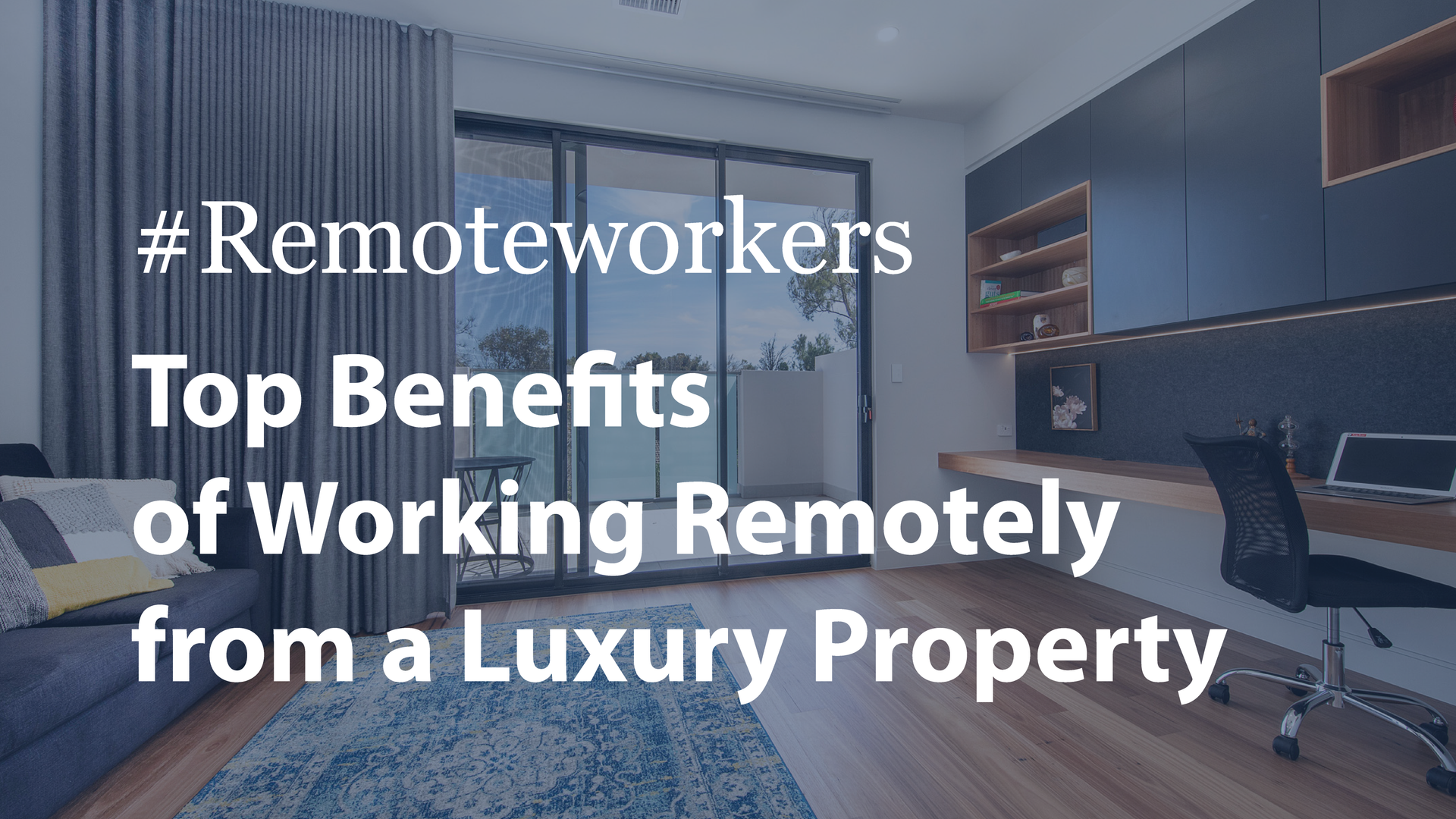The Power of Interior Design
Australian Luxury Stays • January 23, 2024
5 Reasons why Good Interior Design Increase Bookings
1. Memorable Experience: A well-designed interior creates a lasting impression on guests, making them feel welcomed, comfortable, and inspired. This positive experience can lead to increased bookings and recommendations to others.
2. Functionality: Efficient use of space and well-thought-out interior design can optimize the layout, flow, and utilization of space in a property. This can result in a seamless and convenient stay for guests, leading to positive reviews and repeat bookings.
3. Brand Identity: Interior design can reflect the personality and character of a property, setting it apart from the competition. A unique brand identity conveyed through interior design can attract guests who resonate with its style and vibe, leading to increased bookings.
4. Social Media Appeal: In the age of social media, the visual appeal of a property is crucial. Guests often share their travel experiences on social media, and a well-designed interior can be a major selling point. Eye-catching interiors can generate buzz and attract attention, leading to increased bookings and exposure on social media platforms.
5. Guest Comfort: Interior design greatly impacts the comfort of guests during their stay. Comfortable furniture, cozy lighting, and climate control can create a welcoming and inviting atmosphere. Positive guest experiences lead to higher guest satisfaction, positive reviews, repeat bookings, and word-of-mouth recommendations, ultimately leading to increased bookings.
In summary, good interior design increases bookings by creating a memorable experience, enhancing functionality, reflecting brand identity, appealing on social media, and increasing guest comfort. It is an important investment for property owners and managers to boost bookings and create a successful hospitality business.
Share
Tweet
Share
Mail

By Tina Villis
•
August 28, 2024
Traveling overseas for more than six months—whether for work, adventure, or personal reasons—doesn’t mean your property has to sit idle. In fact, it can generate income while you’re away, turning your absence into an opportunity. Here’s how: 1. Short-Term Rentals: Platforms like Airbnb and Booking.com offer a fantastic way to generate income from your property through short-term rentals. By listing your property, you can attract travelers seeking temporary accommodations. To manage bookings, cleaning, and guest communications, consider hiring a property management company. This hands-off approach ensures your property is well-maintained, even while you’re abroad. 2. Long-Term Rental: If you prefer a more stable income stream, renting your property for the entire six months to a long-term tenant might be ideal. This approach minimizes the hassle of frequent turnovers. To ensure your property is in good hands, take the time to find a reliable tenant. Again, a property manager can be invaluable, handling everything from tenant screening to maintenance. 3. Vacation Rentals: For those with properties in desirable vacation destinations, marketing your home as a vacation rental can be particularly lucrative. Vacationers are often willing to pay premium rates, especially during peak seasons. While this option may require more effort in terms of marketing and management, the potential returns are significant. 4. Hiring a Property Management Company: If managing a rental from overseas sounds daunting, a property management company can take over the heavy lifting. They handle everything from tenant placement to maintenance issues, giving you peace of mind while you’re away. 5. Event or Film Location: If your property has a unique charm or is located in a desirable area, it could be rented out as a location for events, photo shoots, or even film productions. This is a niche market, but it can offer substantial returns if your property fits the bill. Conclusion: Before you start renting out your property, ensure you’re aware of local regulations, insurance requirements, and any tax implications. Consulting with a legal or financial advisor is a smart move to ensure everything is in order. By leveraging these strategies, you can turn your property into a profitable asset while enjoying your time overseas. Not only will this help cover your travel expenses, but it also ensures your property remains occupied and well-maintained. Feel free to chat with us for more information: 0406 046 868. We're here to help! 📩 info@australianluxurystays.com

By Tina Villis
•
July 30, 2024
The property rental market is evolving, with many owners reconsidering their strategies to maximize income and ensure stable returns. With over 20 years of experience in the short-term and long-term accommodation industry, Allrealty and Australian Luxury Stays have witnessed the benefits and challenges of both rental options. Here's an exploration of why many proprietors are shifting their focus from short-term to long-term rentals. Understanding the Difference Short-term Rentals Short-term rentals, often referred to as holiday rentals, involve renting out a furnished property for periods less than three months. Guests, as they're known, might stay for a night, a week, or a few months, depending on the owner's circumstances and the property's location. This type of rental has grown in popularity with the rise of platforms like Airbnb, Stayz, and HomeAway, offering guests privacy, space, and the chance to experience local culture. Long-term Rentals Conversely, long-term rentals involve leases typically ranging from six to twelve months, with tenants signing a Residential Tenancy Agreement. Tenants pay a bond, handle utilities like electricity, gas, and Wi-Fi, and rent is paid fortnightly, with the owner receiving payments monthly. This arrangement provides a more stable and predictable income stream for property owners. Why the Shift? Recent market indicators show a growing concern among property owners regarding the sustainability and profitability of short-term rentals. Here are some reasons driving the shift to long-term rentals: Economic Stability Long-term rentals offer a consistent and predictable income, which is particularly appealing in uncertain economic times. Owners can avoid the seasonal fluctuations and vacancy risks associated with short-term rentals. Reduced Management Burden Managing short-term rentals often requires constant attention, frequent guest turnover, and maintenance. Long-term rentals reduce this burden, as tenants typically stay for extended periods, leading to fewer vacancies and less frequent need for cleaning and maintenance. Regulatory Pressures Many cities and regions are introducing stricter regulations on short-term rentals to address housing shortages and community concerns. For instance, a recent ABC News article highlights how regulatory changes are impacting short-term rental markets, pushing owners to consider long-term leases as a more stable alternative. Market Saturation The popularity of platforms like Airbnb has led to market saturation in many areas, increasing competition and reducing occupancy rates for short-term rentals. Long-term rentals can provide a steadier demand, particularly in residential neighborhoods less frequented by tourists. Making the Decision Deciding between short-term and long-term rentals depends on various factors, including the property's location, the owner's financial goals, and the desired level of involvement in property management. Here are some pros and cons to consider: Conclusion The shift from short-term to long-term rentals is a strategic decision that can offer stability and reduced management hassles for property owners. By understanding the benefits and challenges of each option, owners can make informed choices that align with their financial goals and lifestyle preferences. At Allrealty and Australian Luxury Stays, we specialize in managing both short-term and long-term rentals, helping owners navigate these decisions to maximize their property's potential. Connect with me direct to chat more about property management. Mobile phone: 0417 831 596 And visit our website: www.allrealty.com.au and www.australianluxurystays.com.au

By Tina Villis
•
July 2, 2024
As of 2023, approximately 25% of the Australian workforce continues to work remotely, at least part-time, a trend that has stabilised post-pandemic. The adoption of hybrid work models and the growing appeal of flexible work arrangements fuel this sustained shift towards remote work. According to a 2023 survey by Global Workplace Analytics, 80% of digital nomads in Australia report an improved work-life balance compared to traditional office settings, and 75% indicate higher productivity while working remotely. The ability to work remotely from anywhere in the world has transformed how people approach both work and travel. As more individuals embrace this lifestyle, the demand for accommodation that caters to remote work needs has surged. At Allrealty and Australian Luxury Stays, we understand the evolving needs of today’s digital nomads, and this is why we offer a range of luxury, fully furnished accommodation designed to enhance the remote work experience for short-term stays and long-term leases. South Australia has been actively promoting itself as a destination for digital nomads, with Adelaide offering a blend of city life and access to nature. Many digital nomads prefer renting fully furnished properties, contributing to the demand for short-term and flexible accommodation options. Top Benefits of Working Remotely from a Luxury Property 1. Encourage Focus and Creativity Remote work offers the freedom to choose one’s workspace, and what better backdrop for productivity than a luxurious home? Our properties are strategically located in picturesque settings across South Australia, providing an inspiring environment that encourages focus and creativity. Whether nestled in the serene countryside or overlooking breathtaking coastal vistas, each of our homes offers a unique ambiance conducive to remote work. 2. Seamless Connectivity We recognize that a stable internet connection is non-negotiable for remote work. That’s why all our luxury homes are equipped with high-speed Wi-Fi, ensuring that digital nomads can stay connected and productive throughout their stay. Say goodbye to the frustration of unreliable internet connections; our properties are designed to meet the demands of modern remote workers. 3. Work-Life Balance Redefined One of the greatest advantages of remote work is the ability to strike a balance between professional commitments and lifestyle. Our luxury homes provide the perfect retreat for digital nomads to unwind after a day of work. Whether it’s enjoying a property or offering ample spaces to recharge and relax your mind. 4. Workspaces Designed for Productivity We understand that a dedicated workspace is essential for remote work success. That’s why many of our homes feature designated work areas equipped with suitable furniture and ample natural light. Whether you prefer a cozy study with panoramic views or an outdoor terrace overlooking lush gardens, we have the perfect workspace to suit your needs. As the digital nomad trend continues to gain momentum, the demand for accommodation that cates for remote work needs will only increase. We are committed to providing digital nomads with luxury accommodation that not only meet their practical requirements but also elevate their overall remote work experience. With stunning locations, seamless connectivity, and thoughtfully designed workspaces, our properties are the perfect choice for those looking to combine work and travel seamlessly. Experience the future of remote work with Allrealty and Australian Luxury Stays and redefine the way you work and live. Browse our carefully curated portfolio of inspiring homes and book your next workcation here: www.australianluxurystays.com.au

By Tina Villis
•
February 19, 2024
February is Book Direct Month for Australian Luxury Stays, a yearly celebration of the power of booking directly with a vacation rental property. The purpose of this is to encourage travellers to book either through a "No Booking Fee" website or just directly through the property owner or management company instead of relying on third-party booking sites such as Airbnb, VRBO, Expedia, and Booking.com. This year’s #BookDirectDay is being celebrated on the first Wednesday of February, but we are ready to celebrate the whole month with news and tips. We are focusing on educating guests on how they can save money and get a tailored vacation experience by booking your monthly vacation rental directly. Discover the top seven reasons to book your holiday rental directly with us: 1. Unlock the Best Deals: Book Directly with Us at Australian Luxury Stays Did you know that major travel sites like Airbnb, HomeAway, VRBO, and TripAdvisor often add significant fees to your booking total? Avoid these extra costs by booking directly with the property owner or manager. 2. Why Direct Contact Makes Your Stay Better When booking a holiday rental, peace of mind is paramount. Have questions about the property or need more information before booking? By communicating directly with the person in charge, you can get the answers you need to make an informed decision. 3. The Best Prices Are Found Directly, Not on OTA's Contrary to hotels, online travel agencies (OTA's) like Airbnb, Booking, and Expedia don't always offer the best prices. You can save hundreds by booking directly or locally. If you prefer using OTA's, look out for business names or phone numbers, as booking through their website or calling directly can result in savings. 4. Discover Hidden Gems Off the Beaten Path Many of the finest vacation rentals aren't listed on major sites. Due to the high costs associated with these platforms, some exceptional homes need additional help to be discovered. By expanding your search beyond online travel agencies, you can find unique properties that may not be easily found otherwise. 5. Tap into Local Expertise Property managers and owners have intimate knowledge of both the destination and the home itself. They can recommend the best rental for your needs and provide insights into the top activities, restaurants, and local service providers. 6. Catering to Your Special Requirements Whether you have special needs like no stairs or want to bring your pets along, a manager or owner can assist you in finding a suitable accommodation that meets your specific requirements. 7. Exclusive Offers and Deals By booking directly with the owner or manager, you can access special offers and discounts that are often available during non-peak travel times. Be the first to know about these exclusive deals by communicating directly with us. Ready to experience luxury without the hidden fees? Visit Australian Luxury Stays on our website www.australianluxurystays.com.au and #BookDirect. We're excited to host your stay!

By Australian Luxury Stays
•
January 30, 2024
Welcome to the NEW edition of 'Be our Guest' , Newsletter is back, and better than ever! Sit back, relax, and absorb all the interesting articles, new properties, and new experiences that may inspire you to book another holiday break or business trip with us!

By Australian Luxury Stays
•
January 23, 2024
It is advisable to be aware of the Pros and Cons to choose the option that best suits you. THE PROS There is superior rental return for the right property in the right location with a property management company specialising in accommodation There are tax advantages associated with depreciation on furniture packages Furnished properties provide flexible options for short, medium or long term stays Refurbishment of your property can also mean that the presentation is contemporary and inviting, with the additional bonus of increasing the property’s capital value You and your family and friends can use the property on an intermittent basis. This option works if you own a holiday home and is also great for investors who live interstate or overseas and use their property for recreation or for business If moving overseas or have excess furniture, renting your property furnished will save on storage If you are away for a length of time or on an overseas trip, you will receive an income and having your property managed and maintained will provide peace of mind You can attract different clientele by aiming at the executive relocation market and overseas visitors Seaside holiday homes can be subsidised with holiday rental income if the investor is seeking both a lifestyle and investment When there is a glut of rental properties, having a furnished property for shorter stays can be a point of difference in an overcrowded market This style of accommodation is becoming increasingly popular as it offers an alternative to a hotel or serviced apartments and it can be cost saving, accommodating more than one group of people If you have purchased a new home and are unable to sell your current home, the option of receiving income from a short term lease can be appealing while you wait for the property to be sold Your property is always maintained and in pristine condition. With regular housekeeping service, your property is monitored frequently and any maintenance issues can be attended to immediately THE CONS This option may not suit you if you need a consistent rental income. The financial outlay to fully furnish the property. More furniture and appliances mean more money for maintenance and general wear and tear. There is a higher risk of theft of appliances. However, this is covered with written terms and conditions and accommodation bonds or refundable deposits and landlord insurance. You need to be prepared to outlay money on a reasonably frequent basis to replace furniture and smaller items such as cutlery or bed linen which can become damaged, worn or simply go missing due to high turnover of guests. Management fees will be higher to account for additional hours required with more frequent bookings to; scheduling housekeeping services; servicing and maintenance of equipment; management of supplies etc. There will be establishment costs depending on the owners’ requirements, including a full inventory, professional photography, refurbishing and redecorating advice and assistance. You may need to refurbish every five years or so as the guests who seek this type of accommodation from the higher socio-economic bracket expect the highest quality fit-outs and all mod cons. They are also prepared to pay at the higher end For a further discussion please contact the Australian Luxury Stays please phone us on MB: 0499 946 468

By Australian Luxury Stays
•
January 23, 2024
Home owners, property investors and developers are now attracted to the short-term rental market, as they see this as an opportunity to maximise their financial returns. With the increase in the demand for short-term accommodation, we are also seeing an increase in guest expectations. A property owner who is considering joining this booming segment of the sharing economy, needs to consider market trends and guest desires, in order to achieve strong returns and create a successful business. The medium-long term leasing options for furnished properties is also a growing trend with an increase in tenant expectations as well. 1. THE HOME IS NOW A PLACE OF BUSINESS so the owner cannot be too emotionally attached to the property 2. DECOR REIGNS SUPREME - KEEP FURNISHINGS & STYLING MODERN • Good quality furniture is essential • Avoid using cheap furniture or furniture that has passed its 'use-by date' • Beds need to be comfortable, with good quality mattresses for a good night's sleep • Avoid bunk beds for occupational, health and safety reasons • Linen needs to be quality, hotel standard • Use colourful decorative cushions, lamps & artwork • For a luxurious elegant look, add couch throws & bed runners • Plants are an essential element in the decorating mix, so choose in-door plants which require minimal care. Good quality imitations of natural plants is the best option. 3. INVEST IN PROFESSIONAL PHOTOGRAPHY • First impressions count, so use good photos to enhance the best features of the property • Include cameo-shots, as guests want to see where they will sleep, dine or relax • High-quality photography can increase the enquiry rate & conversion to a booking, by up to 40% 4. UNLIMITED WI-FI IS MANDATORY NON-NEGOTIABLE 5. A GOOD QUALITY COFFEE MACHINE • Nespresso brand coffee machines are most popular • A quality coffee machine has the same priority as Wi-Fi - it is non-negotiable 6. STATE OF THE ART TECHNOLOGY • Smart TV's are the expected standard & should be located in each living area, with the very minimum being one in the master-bedroom 7. OUTDOOR ENTERTAINING is an integral part of the Australian lifestyle The property must include: • A quality, easy clean BBQ • An out-door setting • 8. EXPECT WEAR & TEAR • It is a normal part of renting, with guests coming and going with luggage, children and possibly, pets. • There may be a scuff mark left on a wall, or furniture may have been moved from one place to another however in the big scheme of things, these are issue which can be easily addressed. 9. REGULAR MAINTENANCE will ensure the property is guest-ready • Guests can be unforgiving with problems like unstable Wi-Fi, limited downloads, faulty, or ineffective, cooling and heating systems 10. PET-FRIENDLY vs OWNER PETS • Pet-friendly accommodation is highly sought-after and these are the first properties to be booked or rented long term • Owners who holiday in their own property with their pets, yet stipulate no pets for quests need to carefully consider this policy • A guest who has an allergy to pets will book a non-pet-friendly property on the assumption that pets have not been allowed in the property. Consider the possibility of health issues & serious complication if the prescribed pet-policy is not adhered to. 11. IF AN OWNER WISHES TO SELL • Forward bookings must be honoured in writing • Relocation of the bookings must be negotiated with the guests in a timely manner 12. OWNER BOOKINGS FOR SHORT TERM STAYS • The usual check-in and check-out procedures must be followed, to avoid delays in arrivals & departures • Consider the impact and resultant stress on house-keeping staff 13. COMMUNICATION PROTOCOL • Office hours are 9-5pm. Phone or call into the office are anytime during these hours • Non-urgent business, after-hours, needs to be addressed via a phone or text message • In an emergency after-hours, phone, leave a voice or text message. • Email any time 14. INSURANCE • Purchase a policy which is specifically tailored for the short-term rental market 15. WE ARE THE PROFESSIONALS SO LET US MANAGE YOUR PROPERTY • Owners can be assured that we are specialists in our field, and that we will set appropriate rates, with the flexibility to adjust with dynamic pricing • Allow us to apply our expertise and present you with our very best service - this is what you pay us to do. Enjoy Your Journey With Allrealty & Australia Luxury Stays

By Australian Luxury Stays
•
January 23, 2024
Trust and credibility: Referrals from satisfied guests create trust and credibility for your short stay property. When potential guests hear about your property through a referral from someone they trust, they are more likely to book with confidence, knowing that others have had a positive experience. Word-of-mouth marketing: Referrals can lead to word-of-mouth marketing, which is a powerful and cost-effective way to increase bookings. When guests refer your property to their friends, family, or colleagues, it can result in new bookings without any additional marketing efforts on your part. Personal connection: Referrals create a personal connection between the referrer and the potential guest. This personal touch can evoke an emotional response and make the potential guest more likely to book as they feel a sense of connection with someone who has recommended your property. Higher conversion rate: Referrals have a higher conversion rate compared to other marketing channels. When a potential guest receives a referral, they are more likely to convert into a booking as they already have a positive recommendation from someone they know and trust. Repeat bookings: Referrals can lead to repeat bookings from the same referrer or their network. When a referrer has a positive experience at your property and refers others, those referred guests may also become repeat guests, resulting in increased bookings over time. In summary, referrals can help increase bookings for your short stay property by building trust and credibility, generating word-of-mouth marketing, creating a personal connection, leading to higher conversion rates, and potentially resulting in repeat bookings. It's important to prioritize guest satisfaction and encourage referrals as part of your marketing strategy to boost bookings and grow your business. Simplifying the text highlights how referrals can help increase bookings for short stay properties by building trust, generating word-of-mouth marketing, creating a personal connection, leading to higher conversion rates, and potentially resulting in repeat bookings. The simplified text retains the key points of the original text in a concise manner.
Need help finding your Perfect booking?
About Us
Looking for furnished property management specialists who can cater to your short to long-term accommodation needs?
Look no further than us! We specialize in providing flexible and fully furnished accommodation that are perfect for holidays, relocation, corporate trips, and work contracts. Our properties are designed to offer not just convenience and comfort but are also tailored to suit any type of stay, whether it's just a few days or many months. Choose us for a hassle-free and comfortable stay!
